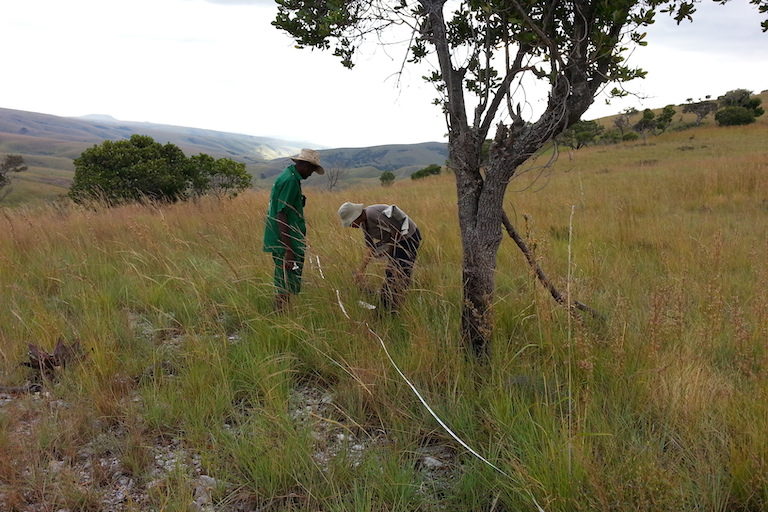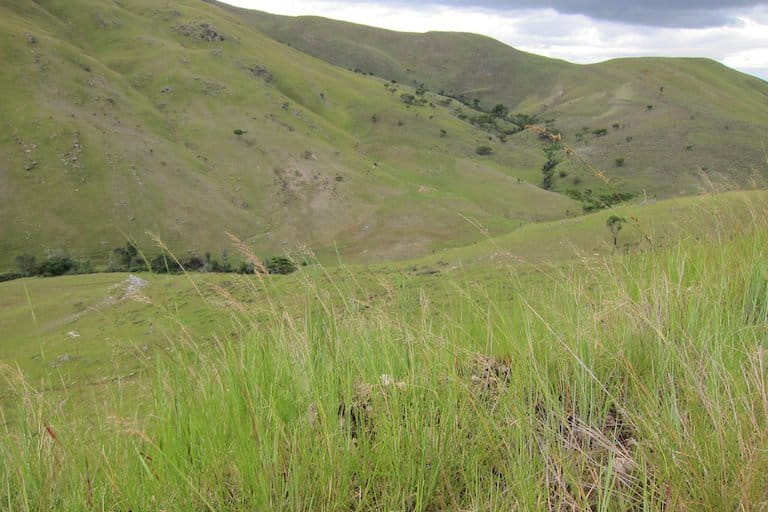- Grasslands cover most of Madagascar’s land area, but they are often regarded as nothing more than former forests, denuded by human destruction.
- In the last 15 years, scientists from Madagascar and abroad have set out to restore grasslands’ reputation as ancient and valuable ecosystems in their own right.
- New research shows that some of Madagascar’s grass communities are ancient, having co-evolved with natural fires and now-extinct grazing animals such as hippos and giant tortoises.
Madagascar is often called the “red island” because of its iron-rich soils. In school, Malagasy children are taught that their island was green until human beings destroyed most of the forests — a sort of original sin that’s part of the national mythos. Last year, Madagascar’s president promised to turn it from red to green through a large national tree-planting program.
It is, however, unlikely that Madagascar was ever entirely covered in forests. Researchers debunked the myth decades ago, but it has endured in the popular imagination. Even some scientists have treated the grasslands — which now extend over most of the country — as nothing more than degraded forests, or at least as unworthy of attention. But in the last 15 years, scientists from Madagascar and abroad have set out to put grasslands on firmer academic ground.
The latest installment of their research, published in Proceedings of the Royal Society B last month, shows that many of Madagascar’s grass assemblages — suites of species that grow together — are ancient, having co-evolved with natural fires and now-extinct animals such as hippopotamuses.
“Hopefully this will change how people see grasslands,” Cédrique Solofondranohatra, a Ph.D. candidate in botany at the University of Antananarivo and lead author of the study, told Mongabay. “We used to be taught that grasslands are of no use. The persistent narrative is that only forest has value, and those grasslands we’re seeing are just the result of human degradation and that it’s just wasteland.”

The ancient
Madagascar’s grasslands receive relatively little attention from conservationists. Only three or four of Madagascar’s 100-odd protected areas provide significant protection to grasslands, and even those were designated mainly to protect other habitat types, scientists say.
Yet the country’s grasslands are home to a range of animal species, including termites, lizards, snakes and birds. There are 541 known grass species, 40% of which are unique to Madagascar. In fact, grasslands cover roughly 65% of Madagascar’s land area, including most of the central highlands where Solofondranohatra conducted her research.

She found that, as elsewhere in the world, the grasses cluster together in two groups: those adapted to grazing and those adapted to fire.
The study highlights the role that animals played in the grazing grasses’ evolution. Ancient Madagascar had large grazing wild animals such as hippos (genus Hippopotamus) and giant tortoises (genus Aldabrachelys) that ate both the tops of the grasses and the nearby plants that would have otherwise blocked out the sunlight reaching the grasses. (Research is ongoing into the diets of Madagascar’s humungous ancient elephant birds (genera Aepyornis,Mullerornis and Vorombe); they may have eaten grass as well.)
When the grazing animals went extinct, these grasses would not have survived if not for what Solofondranohatra calls a “megafaunal substitute”: cattle. Humans arrived at least 2,000 years ago, and introduced cattle at some point thereafter. Cattle and wild megafauna likely overlapped for about 1,000 to 1,500 years, with the “substitution” happening gradually. The peak of the megafauna die-off, with populations crashing, was roughly 850 C.E., paleontologists believe, and the big animal species went extinct over the next several centuries.
Today, grazing grasses are often found near villages, while fire-adapted grasses typically thrive in more remote areas. The fire grasses are long and have thick leaves that are both highly flammable and not so easily digested by animals. Getting burned is in their DNA, one might say. Unlike many plant species, their roots survive large fires, so when other species die out, they propagate. Natural fires were common on the island before the arrival of humans, and the grasses evolved accordingly, Solofondranohatra said. “The presence of endemic fire grass species strengthens the evidence that some extent of fire-maintained grasslands is an ancient part of the region,” she and her co-authors write in the study.

Some of the interest in Madagascar’s grasslands can be traced back to the work of biologist David Burney, who found evidence of ancient fires and grasslands in a 1987 study. Ancient Madagascar had a mosaic landscape of forests, heaths, marshes and grassland, research by Burney and others indicates. The details of any given era, however, remain unclear, as the fossil and paleoecological record is incomplete. Exactly how much grassland there was outside of forests, and to what extent today’s grasslands are “primary” rather than denuded forest, remains a matter of inquiry and debate.
As a botanist, Solofondranohatra looked at how grasses function today in order to understand how they evolved in the past, and deduced an important historical role for grasslands, raising the possibility that the human impact on forests has been overstated. However, paleontological and paleoecological research doesn’t tell the same story, at least not so far.
The fossil record does not provide strong support for the idea that Madagascar’s grasslands were extensive before human arrival. It indicates that fire frequency and grass coverage increased from about 700 C.E., likely due to human impact, not changes in rainfall or climate. The island’s big animals subsequently changed their diets, eating fewer leaves from trees and more grasses, presumably because their landscape had changed.
“Nobody disputes that the grasslands are ancient — they arrived in Madagascar, as virtually everywhere, in the Miocene,” Laurie Godfrey, a paleontologist at the University of Massachusetts Amherst who has worked in Madagascar for decades, told Mongabay in an email, referring to a time period that ended more than 5 million years ago. “However, there is also a lot of evidence of regional and local fires [in the last 1,300 years or so] — in many places — that are too intense and sustained to be natural fires. These are human induced, and they significantly changed the landscapes.”
The extent of grasslands fluctuated during ancient periods, Godfrey said, citing pollen records. She cautioned against casting the origins of grasslands as an “either/or” question. “It is true that the grasslands are old,” she wrote. “It is also true that Madagascar’s habitats underwent significant transformation by humans during the past millennium, and somewhat earlier. This transformation did indeed replace some forests with grasslands.”
Godfrey and other scientists interviewed for this article pointed out that regardless of what happened in antiquity, there’s no doubt that the deforestation rate has been very high in recent decades and poses a major threat to Madagascar’s biodiversity. Godfrey said the recent trend was “scary as hell.”

The here and now
Solofondranohatra’s botanical research is in the mold of William Bond, an emeritus biology professor at the University of Cape Town who drew attention to Madagascar’s grasslands in a 2008 study. Bond has championed the ecological role of tropical grasslands and challenged the conception of them as degraded forests. In a 2016 article in Science, he argued against rushing to plant trees in ancient grasslands, which can act as better carbon sinks than forests. One reason is that grasses store carbon underground, but trees emit much of their carbon dioxide when they burn.
This debate has immediate policy implications in Madagascar, where the government has set in motion a massive tree-planting program in the last year. The program includes planting non-native species such as eucalyptus and pine in the grasslands.
Though these fast-growing fuelwood and timber species bring benefits, planting them in grasslands is ill advised, some scientists say. The government should instead focus on planting trees in recently cleared areas along the edges of forests, Christian Kull, a geographer at the University of Lausanne in Switzerland who specializes in environmental change in Madagascar, told Mongabay during an interview about Solofondranohatra’s study. He cautioned against turning Madagascar into Australia, where landscapes covered in highly flammable eucalyptus have been subject to intense wildfires.
Caroline Lehmann, a biogeographer at the University of Edinburgh and co-author of the study, raised similar concerns about the tree-planting program. Madagascar could face increased fire risks if eucalyptus and pine continue to be planted, she told Mongabay. Grasslands should be recognized as ecosystems that play a crucial role in raising livestock for food and maintaining healthy watersheds, she said.
Madagascar’s environment ministry did not respond to questions from Mongabay regarding these concerns.

Banner image: A Madagascar munia (Lonchura nana), a species of finch that frequents grasslands. Image by Francesco Veronesi from Italy via Wikimedia Commons (CC BY-SA 2.0).
Citations:
Solofondranohatra, C. L., Vorontsova, M. S., Hempson, G. P., Hackel, J., Cable, S., Vololoniaina, J., & Lehmann, C. E. (2020). Fire and grazing determined grasslands of central Madagascar represent ancient assemblages. Proceedings of the Royal Society B: Biological Sciences, 287(1927), 20200598. doi:10.1098/rspb.2020.0598
Vorontsova, M. S., Besnard, G., Forest, F., Malakasi, P., Moat, J., Clayton, W. D., … Randriatsara, F. O. (2016). Madagascar’s grasses and grasslands: Anthropogenic or natural? Proceedings of the Royal Society B: Biological Sciences, 283(1823), 20152262. doi:10.1098/rspb.2015.2262
Douglass, K., Hixon, S., Wright, H. T., Godfrey, L. R., Crowley, B. E., Manjakahery, B., … Radimilahy, C. (2019). A critical review of radiocarbon dates clarifies the human settlement of Madagascar. Quaternary Science Reviews, 221, 105878. doi:10.1016/j.quascirev.2019.105878
Burney, D. A. (1987). Late Quaternary stratigraphic charcoal records from Madagascar. Quaternary Research, 28(2), 274-280. doi:10.1016/0033-5894(87)90065-2
Burney, D. A. (1987). Late Holocene vegetational change in central Madagascar. Quaternary Research, 28(1), 130-143. doi:10.1016/0033-5894(87)90038-x
Bond, W. J. (2016). Ancient grasslands at risk. Science, 351(6269), 120-122. doi:10.1126/science.aad5132
Bond, W. J., Silander Jr., J. A., Ranaivonasy, J., & Ratsirarson, J. (2008). The antiquity of Madagascar’s grasslands and the rise of C4 grassy biomes. Journal of Biogeography, 35(10), 1743-1758. doi:10.1111/j.1365-2699.2008.01923.x
FEEDBACK: Use this form to send a message to the editor of this post. If you want to post a public comment, you can do that at the bottom of the page.
"claim" - Google News
June 09, 2020 at 06:30PM
https://ift.tt/2YnJ4rE
Grasslands claim their ground in Madagascar - Mongabay.com
"claim" - Google News
https://ift.tt/2FrzzOU
https://ift.tt/2VZxqTS
Bagikan Berita Ini















0 Response to "Grasslands claim their ground in Madagascar - Mongabay.com"
Post a Comment